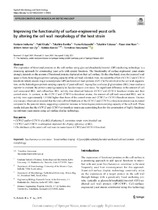| dc.contributor.author | Haan, Riaan | |
| dc.date.accessioned | 2021-09-01T04:32:43Z | |
| dc.date.available | 2021-09-01T04:32:43Z | |
| dc.date.issued | 2021 | |
| dc.identifier.citation | Inokuma, Kentaro & Kitada, Yuki & Bamba, Takahiro & Kobayashi, Yuma & Yukawa, Takahiro & Den Haan, Riaan & Zyl, Willem & Kondo, Akihiko & Hasunuma, Tomohisa. (2021). Improving the functionality of surface-engineered yeast cells by altering the cell wall morphology of the host strain. Applied Microbiology and Biotechnology. 105. 1-10. 10.1007/s00253-021-11440-6. | en_US |
| dc.identifier.uri | 10.1007/s00253-021-11440-6. | |
| dc.identifier.uri | http://hdl.handle.net/10566/6580 | |
| dc.description.abstract | The expression of functional proteins on the cell surface using glycosylphosphatidylinositol (GPI)-anchoring technology is a promising approach for constructing yeast cells with special functions. The functionality of surface-engineered yeast strains strongly depends on the amount of functional proteins displayed on their cell surface. On the other hand, since the yeast cell wall space is finite, heterologous
protein carrying capacity of the cell wall is limited. Here, we report the effect of CCW12 and CCW14 knockout, which encode major nonenzymatic GPI-anchored cell wall proteins (GPI-CWPs) involved in the cell wall organiza- tion, on the heterologous protein carrying capacity of yeast cell wall. Aspergillus aculeatus β-glucosidase (BGL) was used as a reporter to evaluate the protein carrying capacity in Saccharomyces cerevisiae. No significant difference in the amount of cell wall–associated BGL and cell-surface BGL activity was observed between CCW12 and CCW14 knockout strains and their control strain. In contrast, in the CCW12 and CCW14 co-knockout strains, the
amount of cell wall–associated BGL and its activity were approximately 1.4-fold higher than those of the control strain and CCW12 or CCW14 knockout strains. Electron microscopic observation revealed that the total cell wall thickness of the CCW12 and CCW14 co-knockout strains was increased compared to the parental strain, suggesting a potential increase in heterologous protein carrying capacity of the cell wall. These results indicate that the CCW12 and CCW14 co-knockout strains are a promising host for the construction of highly functional
recombinant yeast strains using cell-surface display technology. | en_US |
| dc.language.iso | en | en_US |
| dc.publisher | Springer | en_US |
| dc.subject | Saccharomyces cerevisiae | en_US |
| dc.subject | Yeast surface display | en_US |
| dc.subject | Glycosylphosphatidylinositol-anchored cell wall protein | en_US |
| dc.subject | cell wall morphology | en_US |
| dc.title | Improving the functionality of surface-engineered yeast cells by altering the cell wall morphology of the host strain | en_US |
| dc.type | Article | en_US |

